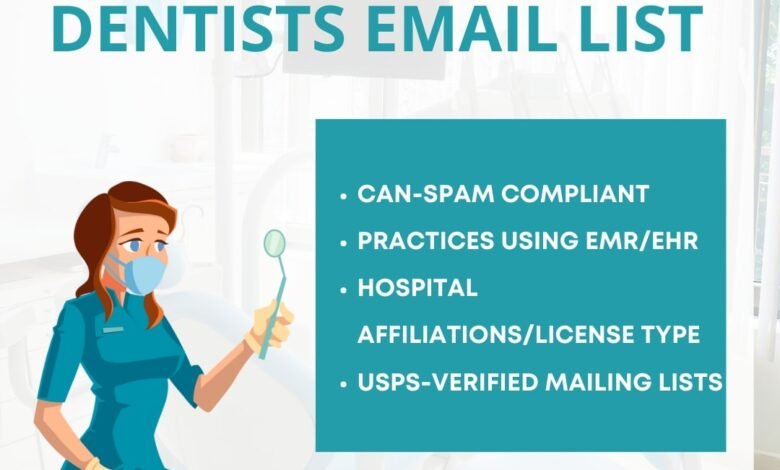
Intro
In today’s fast-paced and competitive healthcare industry, it is crucial for B2B companies to have access to accurate and updated contact information of potential clients. This is where a dentists email list comes in handy. With the growing demand for dental services, dentists have become an essential target market for businesses offering products and services in the healthcare sector. By utilizing a reliable and comprehensive dentists email list, companies can effectively connect with dentists and build strong relationships, leading to seamless and successful B2B campaigns. In this blog post, we will delve into the importance of a dentists email list and how it can greatly benefit B2B healthcare marketing strategies.
Understanding the Importance of Dentists Email List
The dentists email list is more than just a collection of email addresses from various professionals within the dental industry, such as general dentists, orthodontists, and endodontists. This list actually serves as a powerful tool that paves the way for an uninterrupted and direct line of communication between businesses and potential clients.
By utilizing a dentists email list, businesses can extend their reach beyond traditional borders, delivering customized marketing messages straight to the inboxes of potential leads in the dental field. The opportunity to present your products or services directly to the key players in the dental industry can significantly enhance your chances of gaining a foothold in this highly competitive field.
Imagine having the ability to convey your marketing message, introducing your products or services, or even unveiling exclusive offers directly to the email inbox of a dental professional. That’s the power a dentists email list holds. It gives businesses a platform to interact one-on-one with the people who matter most to their business growth.
This advantage is further amplified if the list is segmented based on various factors like specialization, geographical location, or years of experience. Segmented lists allow for even more personalized messages, increasing the chances of resonating with the recipient, and ultimately, driving engagement and conversions.
In a world where connections can make or break business deals, a dentist email database can be a game-changer. It can serve as a catalyst, fueling the growth of a business and taking it to new heights. It’s an investment that businesses seeking to make inroads into the dental industry should seriously consider. It’s not just about collecting email addresses, it’s about building connections, fostering relationships, and growing your business.
How to Build a High-Quality Dentists Email List
Creating an effective dentists email list can seem like a daunting task. However, with the right approach, it’s entirely feasible and well worth the effort. This list becomes a potent tool in your marketing arsenal, so building it with the utmost care and precision is essential.
Begin the process by tapping into professional networking sites. Platforms such as LinkedIn are teeming with professionals from the dental industry. By connecting with these professionals, you’re well on your way to curating a robust list of email addresses.
Another fertile ground for your list is healthcare directories. These online directories are often overlooked goldmines of contact information. Look specifically for directories that cater to the dental industry for optimum results. Likewise, dental association websites are treasure troves of contact information. They provide access to a diverse pool of dental professionals, making them an excellent source for your email list.
Don’t forget about dental trade shows either. These events are perfect opportunities to network and gather business cards. While it requires a more hands-on approach, the potential payoff is significant. Remember, a personal connection often leads to a more receptive email recipient.
Additionally, consider using lead generation services that specialize in healthcare professionals. These services typically have access to comprehensive databases and can streamline the process for you, saving valuable time.
While creating this list, prioritize quality over quantity. A smaller, more targeted list can be much more effective than a larger, generic one. Ensure the contacts you gather are relevant to your business and likely to be interested in your offerings.
It’s also crucial to keep your list up-to-date. Regularly verify and update the information to maintain its accuracy and relevance. Email addresses change, people move, and professionals switch jobs, so routine maintenance is necessary to ensure your list remains a valuable resource.
Building a high-quality dentists email list requires time and effort, but the payoff in terms of business growth and brand recognition is immeasurable. It’s a vital step in creating a successful B2B marketing campaign in the dental industry.
Navigating Compliance with Email Marketing Regulations
Embarking on an email marketing journey can be quite the adventure, especially when it comes to understanding and complying with email marketing regulations. It’s crucial to remember that not all email marketing strategies are lawful. One key regulation to be mindful of is the CAN-SPAM Act, which lays out rules for commercial emails, establishes requirements for commercial messages, gives recipients the right to have you stop emailing them, and spells out tough penalties for violations.
Under this act, your emails must include a clear and straightforward explanation of how the recipient can choose to stop receiving future emails from you. This is typically done by providing a link to unsubscribe from your email list, which should be clearly visible and easy to use. In addition, it’s important to honor these opt-out requests promptly and not make the process unnecessarily complicated or cumbersome.
Remember, the goal is not just to reach as many inboxes as possible, but to build lasting relationships with dental professionals who are genuinely interested in your offerings. This means respecting their wishes and not overwhelming them with unwanted emails.
In this context, being familiar with, and adhering to, email marketing regulations not only keeps your marketing practices above board, but it also promotes trust and respect between your business and its target market.
Moreover, non-compliance can result in hefty fines, not to mention damage to your business’s reputation. So, it’s worth investing time and resources in understanding these rules. Whether you’re sending a thousand emails or just one, the CAN-SPAM Act applies, and penalties can run up to $43,280 per email for violations.
With these insights in mind, successful navigation of email marketing regulations is not just a matter of legal compliance, it’s an essential part of fostering a strong, respectful, and productive relationship with your target audience.
Personalization: A Key to Successful Email Marketing
In a world where inboxes are brimming with unopened emails, standing out is crucial. This is where personalization in email marketing becomes your secret weapon. It’s not just about greeting your recipient by name; personalization goes deeper, molding the content to fit the interests, preferences, and behavior of the reader.
Imagine receiving an email tailored to your specific needs or preferences. You’re more likely to engage, aren’t you? Now, apply this concept to your B2B marketing strategy. By personalizing your emails, you speak directly to the recipient’s needs, increasing the likelihood of engagement and conversion.
Start with the basics. Use the recipient’s name in the email, not just the greeting. Small as it may seem, this can make a world of difference in making your communication feel more personal and less automated.
Next, leverage the power of segmentation from your dentists email list. Remember, the list is not just a collection of email addresses but a mine of information. Use the insights you’ve gleaned from this list to create emails that speak directly to a recipient’s specific role in the dental industry, their location, or their years of experience.
Another effective personalization strategy involves triggering emails based on specific behaviors or actions. For instance, if a dentist visits a specific product page on your website, you can follow up with an email detailing that product or offering a related promotion.
In addition, consider crafting emails that acknowledge significant milestones such as the anniversary of their practice or their birthday. This not only humanizes your brand but also demonstrates that you value your connection with them.
Lastly, don’t forget the power of feedback. Include polls, surveys, or questionnaires in your emails to learn more about your recipients’ preferences. This information can then be used to further refine your personalization strategies.
Remember, personalization in email marketing is all about making your recipients feel valued and understood. It’s about going beyond a one-size-fits-all approach and acknowledging that every dentist, every practice, has unique needs and preferences. When done right, personalization can be the key to unlocking the full potential of your email marketing efforts.
Measuring the Success of Your Email Campaigns
It’s not enough to just send out emails; you also need to assess the effectiveness of your campaigns. This is where tracking and evaluating specific metrics come into play. This allows you to identify the strengths and weaknesses of your campaign, making necessary adjustments to maximize its impact.
Your open rate, which is the percentage of recipients who open your email, is the first metric to consider. A high open rate can indicate that your subject lines are captivating and your emails are reaching the right audience. However, if your open rate is low, you may need to revisit your subject lines or check if your emails are landing in spam folders.
Next, check your click-through rate (CTR), which measures the percentage of email recipients who clicked on one or more links contained in a given email. This can give you insights into how well your content is resonating with your audience and driving them to take action.
Conversion rate, which shows the percentage of recipients who clicked on a link within your email and completed a desired action such as making a purchase or filling out a form, is another crucial metric. This ultimately determines the success of your campaign since it measures how many recipients were persuaded to act upon your call-to-action.
Lastly, keep a close eye on your unsubscribe rate. This reflects the percentage of recipients who opted out of your email list after receiving an email. A high unsubscribe rate might be a sign that your content isn’t meeting your audience’s expectations or that you’re sending emails too frequently.
By carefully monitoring these metrics, you can gain invaluable insights into your campaign’s performance. This data will guide you in tweaking your approach, helping you craft more effective, impactful email campaigns that resonate with your audience and drive results. Email marketing is a powerful tool in your arsenal, and tracking these metrics ensures you’re wielding it effectively.



